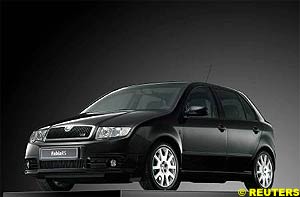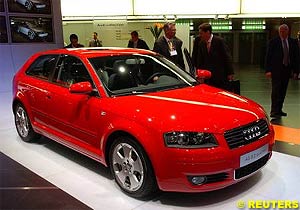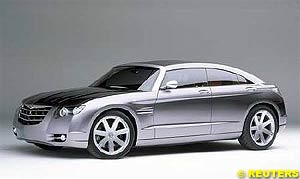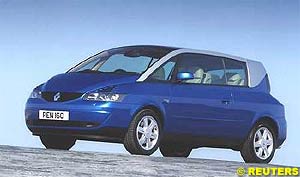

Automotive News and Reviews for the Petrolhead
Reuters Motoring Commentator
In this week's issue:
- Gleaming New Motors on Display in Geneva
- DaimlerChrysler Recalls 50,000 Smart Cars
- Renault Gives Up on Avantime
The first major European motor show of the year got underway in Geneva this week. Along with similar events in Detroit, Tokyo and Frankfurt, Geneva is traditionally a showcase for the very latest mouth-watering metal and this year's show is no exception.
The undisputed headline act of 2003 is the Porsche Carerra GT. Admittedly, it is a car for the very few at more than 250,000 pounds but it never does any harm to dream a little, does it? But be warned - it is impossible to comprehend just how stunning this car is without: a) spending some time simply staring at it before; b) sitting down to let it all sink in.
There is an old racing saying that "if it looks right, it'll go right". It is a theory that is effortlessly proven by the Carrera GT. The engine in this car is a 5.7 litre V10 derivative of a current 5.5 litre Porsche race engine (but of course!). It produces a howling 612bhp (at 8,000rpm), making it good enough for over 200mph. This car is more powerful than nine 1.3 Ford Fiestas and because the Carrera GT weighs little more than a packet of crisps, the sprint to 62mph takes a scant 3.9 seconds. That's about the same amount of time it took you to read this sentence.
Skoda Goes Sporty
For those of us with family commitments, Ford makes a belated entry into the MAV (Multi-Activity Vehicle ≠ an MPV, only smaller) marketplace. Based on the Focus and known as C-MAX, this competitor for the best-selling CitroŽn Picasso is described by Ford as offering the best of both worlds - the space and flexibility of a people carrier but with the driving experience and style of a car. It is only a five-seater (unlike the seven-seat Vauxhall Zafira) because Ford says its target customers don't need any more, but it does offer multiple passenger and load-carrying variations. As might be expected of a family-orientated vehicle, the C-MAX is loaded with a range of safety features including ABS with mechanical assist, side, curtain and front airbags plus ISO fixings for child seats. First models are due into Britain in the autumn.
Summer is on the way and with it comes the desire to take your top off. Mercedes-Benz has a long and distinguished history of this and the latest model to be launched as a convertible is the CLK. This open-top Benz is a four-seater and is also typically technologically advanced, well built and comfortable too. The roof is completely automatic, from inside the car or by remote control, and disappears beneath a cover in seconds, in accomplished Mercedes style. The multi-layered fabric of the roof has also been designed to optimise noise damping when fixed in place. There are currently five different engine choices, from a four-cylinder Kompressor (supercharged) unit to the mighty 367bhp V8 in the CLK 55 AMG. Prices and final specifications are still to be announced and, of course, the car goes on sale in time for the summer.
A Chrysler Fantasy
If the Porsche Carrera GT is the stuff of dreams, then the Chrysler Airflite is still a genuine fantasy. No leading motor show is complete without a selection of outlandish prototypes and Geneva is traditionally a showcase for any number of such styling studies. Sometimes, these vehicles seem to be little more than egotistical vanity projects. They allow designers to compete in a sort of automotive Mr Universe contest, displaying all their outrageous, impractical lumps and bumps and making people stare but offering precious little else of any consequence.
But back to the Airflite: visually, it bears a passing resemblance to the Crossfire and is "the ultimate expression of functional art," says Trevor Creed, the company's Senior VP of Design. "It is designed to offer true functionality in a beautifully-designed exterior and interior package as exciting as any coupe on the road." Except that the Airflite is a five-door, four-passenger saloon. A "sedan coupe," according to Chrysler, that blends "the passion of Chrysler's design, the styling of a coupe and the practicality and function of a saloon car". Put more simply, the Airflite is stunning to behold.
And so one way or another, we're back to the subject of dreams and the Carrera GT. My dictionary defines the word "dream" in several different ways: "an imagined series of events" and "a cherished hope or aspiration" for example. Sadly, with regard to the Porsche, the definitions also include "vain hope".
DaimlerChrysler says it has recalled about 50,000 of its small Smart cars due to a possible fault with the rear lights.
A spokesman said the fault affected vehicles built in 1999 and 2000 and was probably present in only a few cases. He said the problem probably lay with the group's suppliers Siemens VDO or Delphi.
France's Lagardere says it is halting production of Renault's Avantime car, ending decades of involvement in the car business and torpedoing Renault's boldly designed luxury car.
The decision by Lagardere, whose Matra Automobile unit assembled the Avantime for Renault, ends the media firm's automobile business after decades in which it sold sporty cars to French consumers and captured racing titles.
An industrial source said the move also marked the end of Lagardere's attempts to sell its car assembly unit, which employs about 900 workers. In January, Lagardere said it was in talks with several potential buyers for the unit including Germany's Albert Weber, but the source said that since then the talks had failed.
The decision dashes French car maker Renault's hopes for the Avantime, which was launched in October 2001 amid expectations it would find a niche among the young and wealthy. Some 5,000 have been sold so far, well short of the company's aim to sell 10,000 a year.
"We will not take over production. A transfer of these facilities was considered out of the question because of the cost," a Renault spokesman told Reuters.
He also said the Avantime was based on outmoded technology and that it would take too long to restart production in new factories.
Disappointing Sales
Lagardere said that in December orders for the Avantime averaged only 15 per day, and that despite a marketing drive and launches of other models in the same range, sales were well below target. Last year Renault took back production of its Espace van from Matra, leaving the Lagardere unit with only the Avantime coupe to make at its plant at Romarantin in central France.
Lagardere earlier this week sold its 1.26 percent stake in Renault and Lagardere chief Jean-Luc Lagardere quit the Renault board last week. Despite the split, both companies said they would honour service contracts with Avantime and Espace clients. Lagardere said it would also do its utmost to preserve jobs at its Matra factories.
The quirky Avantime was the flag bearer of Renault's bold new take on design that spawned the new love-it-or-hate-it Megane and the Vel Satis hatchback luxury saloon. Lagardere has assembled a number of vehicles for Europe's fourth-largest carmaker through Matra. It had hoped to sell the division by the end of last year.
Lagardere was for years an aerospace and engineering group that also owned a magazine business, but has been metamorphosing into a pure media group in recent years under the direction of Jean-Luc's son Arnaud Lagardere.
Written by Rebecca Harrison
![]() Geneva: Gleaming New Motors on Display
Geneva: Gleaming New Motors on Display
 The Carrera GT is the latest in a long line of exotic Porsche models to draw heavily on the company's racing heritage and technical expertise. The mid-engined two-seater is a genuine road car but has a unique race-like composite monocoque chassis, fabricated from a carbon-fibre reinforced plastic, ensuring the Carrera achieves maximum strength with minimum weight. All very F1, as are the gearbox mounted rear suspension wishbones, carbon-fibre clutch (a first on any road car), ceramic/carbon composite brakes and a quite beautiful carbon-fibre body.
The Carrera GT is the latest in a long line of exotic Porsche models to draw heavily on the company's racing heritage and technical expertise. The mid-engined two-seater is a genuine road car but has a unique race-like composite monocoque chassis, fabricated from a carbon-fibre reinforced plastic, ensuring the Carrera achieves maximum strength with minimum weight. All very F1, as are the gearbox mounted rear suspension wishbones, carbon-fibre clutch (a first on any road car), ceramic/carbon composite brakes and a quite beautiful carbon-fibre body.
 From the sublime to the different, but definitely not ridiculous. How about a diesel hot-hatch? Back on planet Earth, Skoda has launched its own innovative sports model, the Fabia vRS and it is powered by a 1.9 litre diesel engine. Not only does this ultimate Fabia look the part (deep front spoiler, 16" alloy wheels, lowered suspension) but it also acts out its role rather convincingly too. A top speed of 126mph and sub 10 seconds for the 0-62mph sprint is splendid enough (particularly for your average Fabia buyer) but the vRS remains mindful of its roots when it comes to economy, returning an impressive 50mpg (combined cycle) too. Inside, sporting touches such as a leather-covered steering wheel, sports seats and stainless-steel pedals all live up to the Fabia's vRS billing and a choice of four dynamic colours add an appropriate finishing touch.
From the sublime to the different, but definitely not ridiculous. How about a diesel hot-hatch? Back on planet Earth, Skoda has launched its own innovative sports model, the Fabia vRS and it is powered by a 1.9 litre diesel engine. Not only does this ultimate Fabia look the part (deep front spoiler, 16" alloy wheels, lowered suspension) but it also acts out its role rather convincingly too. A top speed of 126mph and sub 10 seconds for the 0-62mph sprint is splendid enough (particularly for your average Fabia buyer) but the vRS remains mindful of its roots when it comes to economy, returning an impressive 50mpg (combined cycle) too. Inside, sporting touches such as a leather-covered steering wheel, sports seats and stainless-steel pedals all live up to the Fabia's vRS billing and a choice of four dynamic colours add an appropriate finishing touch.
 Audi's A3 has long been a firm favourite with the junior exec set in Britain and an all-new model is officially launched at Geneva. Visually quite similar to the outgoing model, the new car has a fresh (but not radically different) body shell with extended wheelbase and body width, offering greater interior room. Under the bonnet, a range of new engines complement the new look, including a torquey 2.0 turbo diesel with 140bhp on tap. More powerful models in the range can also be specified with the new and highly acclaimed Audi DSG gearbox. This is one of the few convincing sequential gearboxes available on a passenger car and is yet another legacy of the race track, allowing drivers to change up and down via a pair of F1-style paddles behind the steering wheel. Unlike some other systems, the Audi solution is effectively two three-speed gearboxes operated via two clutches and allows the driver to shift gears in just 0.02 of a second.
Audi's A3 has long been a firm favourite with the junior exec set in Britain and an all-new model is officially launched at Geneva. Visually quite similar to the outgoing model, the new car has a fresh (but not radically different) body shell with extended wheelbase and body width, offering greater interior room. Under the bonnet, a range of new engines complement the new look, including a torquey 2.0 turbo diesel with 140bhp on tap. More powerful models in the range can also be specified with the new and highly acclaimed Audi DSG gearbox. This is one of the few convincing sequential gearboxes available on a passenger car and is yet another legacy of the race track, allowing drivers to change up and down via a pair of F1-style paddles behind the steering wheel. Unlike some other systems, the Audi solution is effectively two three-speed gearboxes operated via two clutches and allows the driver to shift gears in just 0.02 of a second.
 And then sometimes, these jaw-dropping specials happen to make it into production. Chrysler has an impressive track record of showing us such apparently unfathomable beasts and then just getting on and building them. The Dodge Viper still looks like a 'motor show special' today and the first Crossfire, a two-door coupe, rolled off the production line in February, less than two years after being shown to the world as a mere concept in Detroit. Chrysler has more, many more, and they all have names that put you in mind of Hot Wheels racers: Razor; Avenger; Super 8 Hemi; Citadel; and, errr, Kahuna!
And then sometimes, these jaw-dropping specials happen to make it into production. Chrysler has an impressive track record of showing us such apparently unfathomable beasts and then just getting on and building them. The Dodge Viper still looks like a 'motor show special' today and the first Crossfire, a two-door coupe, rolled off the production line in February, less than two years after being shown to the world as a mere concept in Detroit. Chrysler has more, many more, and they all have names that put you in mind of Hot Wheels racers: Razor; Avenger; Super 8 Hemi; Citadel; and, errr, Kahuna!
![]() DaimlerChrysler Recalls 50,000 Smart
DaimlerChrysler Recalls 50,000 Smart
![]() Renault Gives Up on Avantime
Renault Gives Up on Avantime
 In a statement it called the Avantime a "commercial failure" and said the decision to end production "drives Matra Automobile to end its activity in auto construction."
In a statement it called the Avantime a "commercial failure" and said the decision to end production "drives Matra Automobile to end its activity in auto construction."
© 1995-2005 Kaizar.Com, Inc. . This service is provided under the Atlas F1 terms and conditions.
|
Volume 9, Issue 10
Articles
Giancarlo Fisichella: Through the Visor
Guide to the Perplexed: The 2003 Changes
For the Rekord
Australian GP Preview
2003 Australian GP Preview
Australian GP Facts & Stats
2003 SuperStats: Winter Testing Wrap-Up
Columns
The 'New Formula' Trivia Quiz
The Fuel Stop
Bookworm Special
On the Road
Elsewhere in Racing
The Weekly Grapevine
> Homepage |